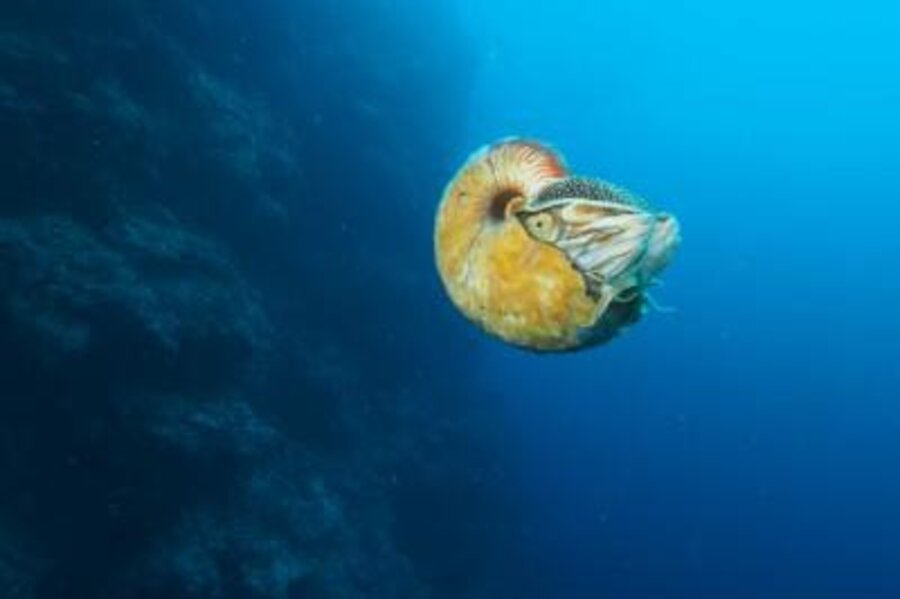From 'fuzzy' nautilus to red colobus monkey: 'living fossils' recovered
Loading...
From molluscs and monkeys to wolves and whales, a number of rare species thought to have gone extinct have been rediscovered, including a handful this year.
Researchers around the world have labored for months and years to find these “living fossils,” which they say can help scientists determine how species have evolved over milleniums, but with each new rediscovery and sigh of relief, they stress that none of these animals are out of the woods yet – at least not so long as humans keep destroying the woods or overfishing the waters they live in.
The most recent rediscovery came from Peter Ward, a University of Washington biologist, earlier this month. Professor Ward was part of the team that first found Allonautilus scrobiculatus – sometimes called the crusty nautilus – 31 years ago, and it hadn’t been spotted in nearly three decades until he found it again off the coast of Papua New Guinea.
Nautiluses are small, distant cousins of squid and cuttlefish, and their shells appear throughout the fossil record over a 500 million year period. Ward and his team, with the help of submerged bait, were able to fix tracking devices to the “fuzzy, slimy” animal and are now learning some of the secrets to the species’ survival.
This may be important, because, as Ward told the UW website, illegal fishing and “mining” operations for nautilus shells – which have already decimated some populations – continue to pose a threat.
“As it stands now, nautilus mining could cause nautiluses to go extinct,” Ward told the website. “This could be the rarest animal in the world. We need to know if Allonautilus is anywhere else.”
Researchers discovered in 2012 that another “living fossil,” a pygmy right whale, was the last known survivor of an ancient whale lineage over 17 million years old. Shy and diminutive by whale standards – it is only 21 feet long and has only been spotted at sea a few dozen times, according to researchers – the discovery has helped researchers piece together the evolutionary history of some of the world’s oldest species.
Earlier this year conservationists nervously celebrated the rediscovery of another rare animal: Bouvier’s red colobus monkey. The species, native to the swampy forests along the Congo River, hadn’t been seen in the wild since the 1970s. A pair of independent explorers – supported by donations through the crowdfunding website Indiegogo – reported seeing the monkey on March 3.
The team made its first sighting of the red colobus monkey on the Bokiba River in the Republic of Congo’s Ntokou-Pikounda National Park, an area that protects gorillas, chimpanzees, and elephants.
“After searching the swamps on the left bank of the Bokiba River for four days, changing camp twice – and just before running out of food, battery, and courage – we finally found a group of Bouvier's red colobus monkeys on Monday," the researchers posted on Indiegogo. “What a beautiful monkey!”
The species had been victimized for decades by loggers and bushmeat hunters, in part because they show little fear of humans, staring at them instead of fleeing. But a number of recently gazetted national parks in the Congo appear to have helped the species survive, according to Fiona Maisels, a biologist for the Wildlife Conservation Society.
“Thankfully, many of these colobus monkeys live in the recently gazetted national park and are protected from threats such as logging, agriculture, and roads, all of which can lead to increased hunting,” she said in a statement at the time.
An endangered species in North America has benefited from similar protections. Earlier this month a family of gray wolves were spotted in California for the first time in almost a century.
A single gray wolf was spotted in the state in 2011 after reportedly wandering down from Oregon, but the family of two all-black adult wolves and five 4-month-old pups are the first gray wolf pack seen in the Golden State since 1924.
Several species of wolves used to roam America’s West Coast, but pressure from encroaching human populations drove them to mountain ranges and other wilderness areas. By the 1990s gray wolf populations were so low that conservationists and biologists pressured the government to reintroduce wolves into Yellowstone National Park. Since then, wolf populations have thrived and they have been making their way back west.
Some researchers see the next frontier of conservation to be de-extinction. The process has never been successfully completed, but in theory, de-extinction utilizes old DNA to clone an extinct animal back into existence. The idea has been proposed for several lost species, from the passenger pigeon to the wooly mammoth.
But critics abound, especially those who say that funneling resources into de-extinction would divert resources needed to protect current endangered species.
“I don’t think it has any merit at all,” Stuart Pimm, a conservation ecologist at Duke University, told Livescience in 2013. “It totally ignores the very practical realities of what conservation is about.”
[Editor's note: This story has been updated to clarify the location of Ntokou-Pikounda National Park. It is in the Republic of Congo.]








